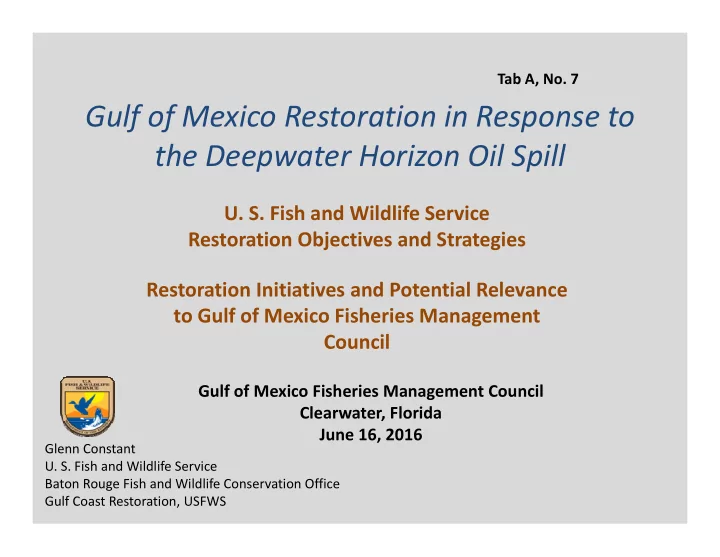

Tab A, No. 7 Gulf of Mexico Restoration in Response to the Deepwater Horizon Oil Spill U. S. Fish and Wildlife Service Restoration Objectives and Strategies Restoration Initiatives and Potential Relevance to Gulf of Mexico Fisheries Management Council Gulf of Mexico Fisheries Management Council Clearwater, Florida June 16, 2016 Glenn Constant U. S. Fish and Wildlife Service Baton Rouge Fish and Wildlife Conservation Office Gulf Coast Restoration, USFWS
http://www.oceanconservancy.org/places/gulf ‐ of ‐ mexico/deeper ‐ dive.html
Proposed Deepwater Horizon Early Restoration Proposals 1109 total Submissions
Funded Deepwater Horizon Early Restoration Projects 10 Funded Projects 0.9 % Funded
Deepwater Horizon Gulf Science and Restoration Initiatives Gulf Coast Ecosystem National Academy North American Restoration Trust Fund of Sciences Gulf Wetland Conservation Research Program RESTORE Act ( $6.3b) Fund ($100m) ($500 m) Programmatic Damage Centers Of Gulf Environmental Direct Assessment Excellence Benefit Fund (NFWF) Component and (2.5%) ($2.5b) (35%) Restoration Plan ($8.8b) Council NOAA Restore Louisiana Selected Alabama Act Science Restoration $356m $1.2b Program Component Gulf Coast (30%) Ecosystem Florida Mississippi Restoration Science, $356m Observation, $356m Spill Impact Monitoring and Component Technology Program (2.5%) (30%) Texas $356m
Vision for a Healthy Gulf of Mexico Watershed (USFWS July 2013) Gulf Restoration Program Team Representatives from all of the Service’s programs Migratory Birds National Wildlife Refuge System Fish and Aquatic Conservation Ecological Services Science Applications Independent State Lead for each state http://www.fws.gov/gulfrestoration/pdf/VisionDocument.pdf
Vision for a Healthy Gulf of Mexico Watershed (USFWS July 2013) “Next Steps” 16 Conservation Focal Areas Northern Gulf Coast Laguna Madre and Lower Rio Grande River Alabama and Florida Panhandle Beaches Valley Texas Coastal Bend Florida Panhandle Austin’s Woods and Prairies Apalachicola River Watershed Chenier Plain Big Bend Springs Conservation Mississippi River Delta, Coastal Wetlands and Southwest Florida Barrier Islands Upper Mississippi River Watershed Atchafalaya River Basin Rainwater Basin Mississippi Alluvial Valley Prairie Pothole Region
“ Next Steps” Draft Focal Areas
Next Steps Restoration Targets (Trust Resources) Threatened and Endangered Species Species Proposed as Candidates for Protection Under ESA (Candidate Species) National Wildlife Refuge System Migratory Birds Interjurisdictional Fish Species / Sportfish Restoration
Next Steps Types of Funded and Proposed Projects Marsh Creation / Wetland Enhancement Oyster Reef Development Land Acquisition Improved Hydrology / Sustainable Freshwater Flows Living Shorelines Science and Monitoring Barrier Island Enhancement and Protection Submerged Aquatic Vegetation Improve Water Quality Conservation Agreements Stocking to Support Sustainable Populations Improved Forest Conditions Fire
“Next Steps” Draft Focal Areas
Deepwater Horizon Gulf Science and Restoration Initiatives Gulf Coast Ecosystem National Academy North American Restoration Trust Fund of Sciences Gulf Wetland Conservation Research Program RESTORE Act ( $6.3b) Fund ($100m) ($500 m) Programmatic Damage Centers Of Gulf Environmental Direct Assessment Excellence Benefit Fund (NFWF) Component and (2.5%) ($2.5b) (35%) Restoration Plan ($8.8b) Council NOAA Restore Louisiana Selected Alabama Act Science Restoration $356m $1.2b Program Component Gulf Coast (30%) Ecosystem Florida Mississippi Restoration Science, $356m Observation, $356m Spill Impact Monitoring and Component Technology Program (2.5%) (30%) Texas $356m
Chapter 5. Restoring Natural Resources 380,000,000 55,000,000 273,300,000
Fish and Invertebrates •A vast volume of open water across the northern Gulf of Mexico was exposed to DWH oil, injuring water column resources. The surface slick alone covered a cumulative area of at least 43,300 square miles (112,000 square kilometers) across 113 days in 2010. The estimated average daily volume of contaminated water under surface oil slicks was 57 billion cubic meters. As a comparison, this volume is approximately 40 times the average daily discharge of the Mississippi River at New Orleans. •Water‐column resources injured by the spill include species from all levels in the food chain, from bacteria to estuarine‐dependent species, such as red drum, shrimp, and sea trout, to large predatory fish, such as bluefin tuna, that migrate from the Gulf of Mexico into the Atlantic and as far as the Mediterranean Sea. •The Trustees estimate that 2 to 5 trillion larval fish and 37 to 68 trillion invertebrates were killed in the surface waters, and between 86 million and 26 billion fish larvae and between 10million and 7 billion planktonic invertebrates in deeper waters. Of these totals, 0.4 to 1 billion larval fish and 2 to 6 trillion invertebrates were killed in estuarine surface waters. The larval loss likely translated into millions to billions of fish that would have reached a year old. Larval fish that were killed but would not have survived to age 1 are also a significant loss; they are an energy source for other components of the ecosystem.
5.5.6 Restoration Type: Fish and Water Column Invertebrates This Restoration Type addresses the overall goal of Replenish and Protect Living Coastal and Marine Resources . The restoration will need to address injuries to the species at different life stages and across their geographic ranges. In accordance with the ecosystem approach to restoration, the Trustees will implement a portfolio of restoration approaches for the water column injury that is three ‐ fold: 1.Coastal and nearshore habitat restoration, discussed and implemented under the Wetlands, Coastal, and Nearshore Habitats Restoration Type (Section 5.5.2), SAV Restoration Type (Section5.5.8) and Oysters Restoration Type (Section 5.5.9). 2.Offshore habitat restoration, discussed and implemented under the Mesophotic and Deep Benthic Communities Restoration Type (Section 5.5.13). 3.Mortality reduction, accomplished by addressing known sources of mortality to fish and invertebrates by reducing bycatch and fisheries interactions discussed and implemented under this Restoration Type (Section 5.5.6).
NOAA RESTORE Act Science Program Gulf Coast Ecosystem Restoration Science, Observation, Monitoring and Technology Program
Recommend
More recommend